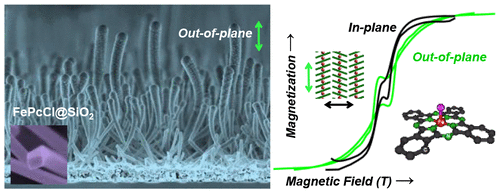A. N. Filippin, V. López-Flores, T. C. Rojas, Z. Saghi, V.J. Rico , J.R. Sanchez-Valencia, J.P. Espinós , A. Zitolo, M. Viret, P.A. Midgley, A. Barranco, A. Borras
Chemistry of Materials 30 (2018) 879-887
DOI: 10.1021/acs.chemmater.7b04515

In this article we show for the first time the formation of magnetic supported organic nanowires (ONWs) driven by self-assembly of a nonplanar Fe(III) phthalocyanine chloride (FePcCl) molecule. The ONWs grow by a crystallization mechanism on roughness-tailored substrates. The growth methodology consists of a vapor deposition under low vacuum and mild temperature conditions. The structure, microstructure, and chemical composition of the FePcCl NWs are thoroughly elucidated and compared with those of Fe(II) phthalocyanine NWs by a consistent and complementary combination of advanced electron microscopies and X-ray spectroscopies. In a further step, we vertically align the NWs by conformal deposition of a SiO2 shell. Such orientation is critical to analyze the magnetic properties of the FePcCl and FePc supported NWs. A ferromagnetic behavior below 30 K with an easy axis perpendicular to the phthalocyanine plane was observed in the two cases with the FePcCl nanowires presenting a wider hysteresis. These results open the path to the fabrication of nanostructured one-dimensional small-molecule spintronic devices.

